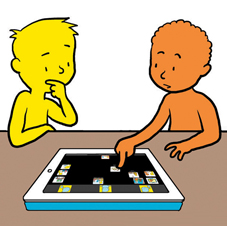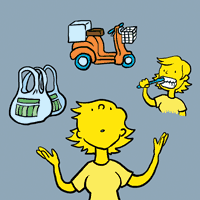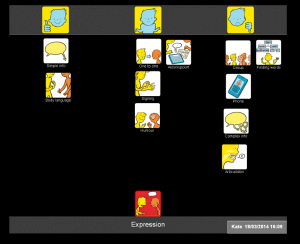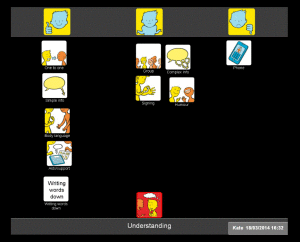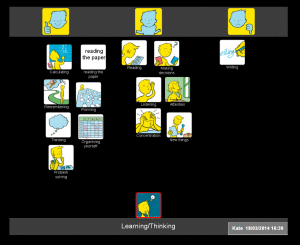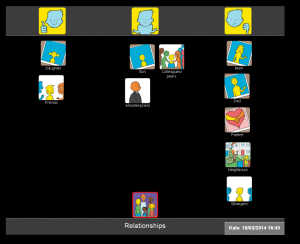We have received a number of requests to create a guide to adding your own images and creating submats with Digital Talking Mats and this blog will show you how.
One of the features of Talking Mats is that we have developed a number of different symbol resources based on our research and clinical practice which cover a wide range of topics.
However, sometimes you may want to personalise what is being communicated about by adding your own images. You may also want to create a submat to explore an existing topic in more detail or you may want to create a completely new topic. In our training courses we explain how to do this when using the original Talking Mats.
However more and more people are now using the digital version of Talking Mats. In a previous blog we described how to add your own photos to the Digital Talking Mats.
We have now made a guide to help those who have the digital version to both add their own images and to create a submat with an example of a sub-mat with the topic “office”.
Download the following pdf to find out how to do it. dtm-a-guide-how-to-add-photos
We would love to hear any stories about making your own digital submats
What are the top 10 blogs for using Talking Mats with adults? Over the years we have posted lots of blogs on different aspects of our framework . If you are working with adults with communication disability these blogs maybe particularly helpful
- Where is the best place to start using the Talking Mats health and well-being resource?
- A blog from Denmark which highlights the effectiveness of using Talking Mats with people with dementia
- Goal setting with a woman with Multiple sclerosis
- Using the app with someone with aphasia
- The development of a resource to help people with learning disability raise concerns
- How can Talking Mats support Capacity to make decisions
- Involving people in their decisions about eating and drinking
- Thoughts on using Talking Mats with people with dementia to explore mealtimes
- Using Talking Mats with someone with a learning disability and dementia
- Use in a rehab setting in South Africa
If you want to explore our resource and training more please visit our shop
Fika (coffee time) in the Talking Mats office is always interesting. Recently we got chatting about Christmas preparations and who had the longest ‘to do’ list. There was a definite variation in enthusiasm for all things Christmas. We needed to do a Talking Mat! This was done on our digital Talking Mats – it’s easy to import your own images now and make a digital Talking Mat about any topic.
Eating , drinking and games and puzzles got the thumbs up! (Lois is the games queen and was the most enthusiastic about that).
Holiday, partying and entertaining got consensus.
Extended family coming to stay? This moved around a bit, but was generally positive (say no more!)
Shopping was in the mid section-we all agreed. Perhaps by now it would be less positive with last minute mayhem.
Gifts was added as a blank (how could the interviewer forget that) and not everyone was comfortable about the commercialisation of Christmas.
‘How do you feel about Juggling demands?’ We all agreed -not sure. Again remember, Talking Mats is how a person feels at a certain point in time. Ask us again on Christmas Eve?!
Christmas cleaning? All agreed was a chore and some thought best not to get too bothered about it
Talking Mats supports a group conversation. We all got our say
Merry Christmas one and all
We are delighted that Nick Stewart, Director, Software and Products with Arum Systems, the IT Consultancy who have built the Digital Talking Mats has chosen TM as his favourite project for a case study.
Here is an extract from his case study describing the Challenge and Process of working with Talking Mats.
The Challenge
The challenge was taking the existing physical Talking Mats tool and building a digital application suitable for multiple platforms, while maintaining the core ethos of the tool. A significant amount of academic research went into creating the physical product and those principles had to be present in a digital version. The applications had to be extremely intuitive to use and enable better conversations for people with communication difficulties.
The aim was to create 3 digital versions; a browser based version for laptop users and a tablet version for iPad users and Android users. Each application would connect to a cloud server, allowing users to log in from any device, and the tablet versions would allow offline working through syncing with the cloud when a connection was available. There was a requirement to set up a multi-tiered subscription based user account system to match the intended charging model for the digital app.
Our Process
Arum’s approach was to totally immerse ourselves in the Talking Mats business to understand their goals, ethos and objectives. We took time to learn how the Talking Mats ecosystem worked and how they wanted to engage with their customers. By applying our 3D Methodology we were able to break down the deliverables into phases allowing the key building blocks to be delivered first. This also allowed the best use of budget and reduced the time to market the new product.
To read the full case study click here Arum Talking Mats Case Study
Sophie Mitchell SLT describes how she supported her students to develop their EHC Plans with the Talking Mats app .
In September 2014 our team and I were asked to facilitate the production of Education and Health Care plans for the Year 14 students at the Secondary Special School (for adolescents with complex, profound and multiple learning difficulties) where we are based. As Speech and Language therapists we were asked to work with the students to gain their view on what they would like to be detailed in their plan and also what their aspirations were for their future. We wanted to ensure the production of these plans were as client centred as possible so therefore decided to use the Talking Mats App on the Ipad using the Health and Wellbeing resource. This resource proved invaluable when working with our students. Not only were our students highly motivated to participate in the sessions due to the Ipad being used, talking mats empowered them to make meaningful decisions about their future, communicate any areas where they would like further support and discuss likes and dislikes. The impact on our students became clear when working with one 19 year old student. Although he did not have any spontaneous expressive language and would only echo things said by others, during a Talking Mats sessions when talking about his likes and dislikes, he appeared to be placing most items under ‘dislike’. As the session went on the student started to appear agitated, then started pointing towards ‘like’ although no symbol was presented. Suddenly the student said ‘Garden’, still pointing towards the ‘like’. When presented with a gardening symbol he soon placed this under ‘like’. This information was then presented in his plan and his college were instructed to explore opportunities for this student to develop his gardening skills. For all students this information was then used to not only create their Education and Health Care plan but also expand and explore areas they were highly motivated by while still at School and also identify possible work placements for the future. Furthermore the School invested in Talking mats training to ensure this approach is used throughout each academic year and school staff are skilled to use Talking Mats as each student starts their assessment for their Education and Health Care plan.
We would like to thank Sophie who is from Sandwell and West Birmingham NHS trust for such a great example of how to use the app in EHC Planning . If you are interested in purchasing the digital Talking Mat then please phone the office 01786479511. We are just changing the purchasing model from subscription to one off sale so its temporarily removed from the web site.
We are delighted to be a Winner in the People Driven Digital Health Awards which were held in Leeds on Friday 3rd July. These awards were instigated to recognise the work of digital health innovators from across the UK and aim to connect the people who have ideas and make them happen.
The event was organised by mHabitat and compered by a well known health commentator, Roy Lilley, of the Academy of Fabulous Stuff. The evening was full of fun and energy and we met lots of interesting people and made good connections. There is loads going on in digital health and services should make use of all these fabulous innovations that will improve people’s lives and health services. To get a flavour of the evening follow #PDDAwards15 and to find out about the other winners click here.
Our category, ‘the most impressive third sector digitally enabled service’ recognises third sector services which have embedded digital tools and services into improving people’s experience and outcomes. We very honoured to win this category with our digital Talking Mat. The announcement of the winners was followed by a flurry on Twitter which you can dip into here .
Many of you have requested the ability to add your own photos into the digital Talking Mat.The new version of the app allows you to do just that.
It is a great feature particularly, if you want to reflect on a particular activity like a day out or a holiday. I thought I would try it when I returned from my recent holiday in Spain . You can see I had a great time the only one downside was the flight (as for some strange reason my husband, Jon and I were not placed in adjacent seats) . I placed shopping in the middle (I might have done a little bit more but I know it’s not really Jon’s cup of tea so I restrained myself!). However there were lots of things I loved, seeing my son in his new apartment in Madrid was great, the walking in the Sierra Nevada stunning, though did involve a lot of up and down ! and Grenada, well, the Alhambra has always been somewhere I wanted to visit and it did not disappoint.
I know that in Talking Mats we have always been slightly cautious about the use of photos but I think where places are concerned and where the photos relate to the immediate experience of the person then they can be really helpful. However, I also think the difference in the image ‘going out for a drink’ and ‘meals out’ demonstrates clearly the pitfall of photos. In the ‘meals out’ photo that I took there is too much visual information and without the written caption you probably would struggle to guess what that photo means. The symbol of ‘going for a drink’ is much clearer and will work for lots of ‘going out for a drink’ situations.There is an additional risk that that the photo of my ‘meals out’ that I took becomes too specific to that particular meal rather than mean ‘meals out’ throughout the holiday if I had taken a photo of a more generic plate of food that might lessen that risk.
Maybe I should have used this photo!
Adding images from your camera roll is an easy feature to use. After you have selected your thinker and added a new session you get to the ‘session set up’ page. There is a button on the top left hand page that says ‘Add local image file’ click this and go to your camera roll. Select the image and type the caption. you can select as many images as you need. The images will then appear after the blanks when you carry out the Talking Mats session with your thinker.
I think this new feature of being able to add your own images means that you could use the Talking Mats in really creative ways. It would be a great way to reflect on a trip e.g. schools could use the photos to talk to the children about their experience of a particularly outing. This could be the basis of a great group discussion projected onto a white board. It could enable people to reflect and express their views on all type of experiences e.g. transitions, work experience, going to college, where to live, visiting their health centre etc.
If you already have the digital pro you will get a free upgrade to include this feature. If you don’t have the digital pro version and want it click here to buy
We are delighted to announce the release of Version 2 of the Talking Mats App
This app has a number of great new features which many of you have been asking for.
There are two new resources – Eating and Drinking – which has 3 main topic sets – Meals, Impact on Health and Things that might help.
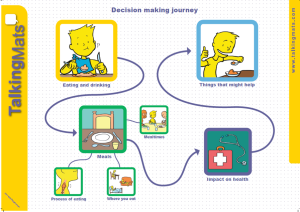
There is an amazing new feature which many people have been asking for. Version 2 allows you to add your own images from your camera roll. This means that you can add you own personalised pictures to any of the topics.
Watch out for next week’s blog when Lois will tell you about her holiday using this new feature!
You can now also reset your password, use the Back button to navigate through the app, delete individual sessions and use the updated report page.
If you have already purchased the gold version of the Talking Mats app you will get all these new features for free.
If you wish to purchase the app please click here or for further information call our office 01786 479511
Many thanks to Helen Paterson, one of our accredited trainers for this fascinating blog.
Now that Talking Mats is accessible in a digital format, the Talking Mats team are often asked ‘Can it be used on an eye gaze device?’ . Of course, for those who use eye pointing reliably, they can use a standard Talking Mat, but there are those individuals with whom we work with who may want to use their eye gaze device to use a Talking Mat, and who find the digital format more accessible. We would suggest that this is only done with a client who is already familiar with eye gaze , due to the extra effort required both to use eye gaze and to make decisions when using a mat. There are many other access methods with which you could use and access Talking Mats Pro, such as a head mouse, chin joystick or touch screen, but for this blog we will focus upon eye gaze. Here’s how we made it possible, and I am sure there may be other ways which we would love to hear about!
- To use Talking Mats Pro directly using eye gaze the person really needs to be calibrated on a device, and they require a level of calibration that is good enough that they are able to access a mouse emulator or Gaze selection on Tobii.
- You must ensure that the mouse emulation or Gaze selection features are set up and the person understands what the features are and what they mean e.g: left click, drag and double click.
- Open up Talking Mats pro on your account.
- You will need to select the topic, topscales and symbols for your client, as this will make it easier with less work for your client, although this is something you would do anyway as the person facilitating the mat.
- Now go through the question and the topscales as you usually would and explain them to your client.
- Select the first symbol and place it on the mat where they can see it.
This is where the 2 systems differ:
Mouse emulation: 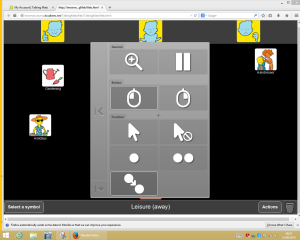
- Client first needs to open the mouse function menu by fixing his or her gaze on the small grey icon which will open the mouse menu.
- Client then fixates gaze to select the drag function (shown above)
- Then the client will select the symbol s/he wants to move by fixating on it.
- Once fixated, they symbol will ‘drag’ around the screen with the clients gaze. 5
- They will then fixate on a point to ‘drop’ it.
See Video
Gaze selection (Tobii):
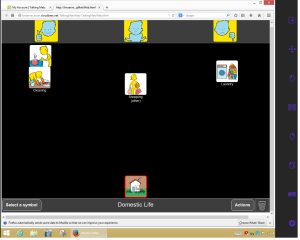
- The client clicks selects drag function at the top of the Menu
- They then look at the symbol 3
- They then look where they wish to place the symbol.
This does require some more thinking on the side of the client as they need to look to where they want it to go and they are not just dragging it as they are in mouse emulation mode.
See video
For individuals who do not have a calibration good enough to use mouse emulation or gaze selection, it is a little more complex. A Talking Mat could be emulated from software such as The Grid 2 or Communicator, but it would not involve the software from Talking Mats Pro or dragging of symbols and moving them to where the person wants them to go.
In the Health and Well-being resource, we have provided four sets of symbols to help people consider how they feel about their communication. Because communication is complex and often abstract, it can be particularly difficult for people to express their views about it, especially if they have existing communication difficulties. To make this easier, we have divided communication into four topics:
- Expression
- Understanding
- Learning and thinking
- Relationships.
In the following example, I show how each topic can be used to build up a picture of how someone feels about different aspects of their communication. I worked with Kate, a 42 year old woman who had a stroke which left her with severe expressive and receptive aphasia. She was able to communicate through vocalisations and gestures. She could sometimes draw or write down words and needed to point to ‘yes/no’ in order to reliably answer closed questions. Following discharge from hospital, I used Talking Mats with Kate to find out how she felt about her communication. I started with the ‘communication – expression’ topic and found that she felt that she was having lots of difficulties making herself understood, particularly on the phone and in group situations:
I then explored how Kate felt about understanding what people were saying to her. Kate was able to tell me that she found it easier to understand people on a one to one basis rather than in a group setting. She indicated that it really helped her if people used gestures or wrote things down. Her main difficulty was understanding people on the phone, and in fact she had stopped answering the phone altogether (see mat below).
We went on to do a mat about Kate’s learning and thinking. In this set, there are symbols which cover higher level language activities such as reading, problem solving and organisation. When we talked about these areas, Kate was able to tell me about the things she was finding most problematic, but could also identify some things that she felt she could still manage (such as calculations and reading newspapers).
I then asked Kate how she felt about communicating with different people in her life. This mat shows that Kate found talking to her husband and her parents (who lived quite far away) particularly difficult.
As a result of doing these mats, we were able to target the things that mattered most to Kate in relation to her communication, and came up with the following actions:
1. Kate felt that her husband needed support and information, so we spent time working with him, showing him the best ways to support Kate’s communication.
2. Because Kate’s parents lived quite far away, she could only contact them using the phone, which was very difficult. We worked on getting Skype set up so that Kate could communicate with her family using all the modes available to her.
By splitting communication into different sub mats, Kate was able to think about different aspects of her communication and identify the things that she found most challenging. Together we began to work out some ways to help her overcome her difficulties.
Use the communication symbols to find out what people want to work on and use a collaborative approach to establish some goals to work on in therapy. I used the original Talking Mats when I explored Kate’s communication with her, but you could do the same with Digital Talking Mats. Find out more about it here.
 Online training login
Online training login 

